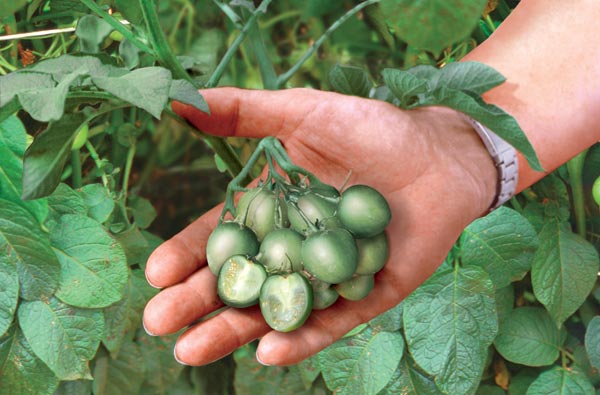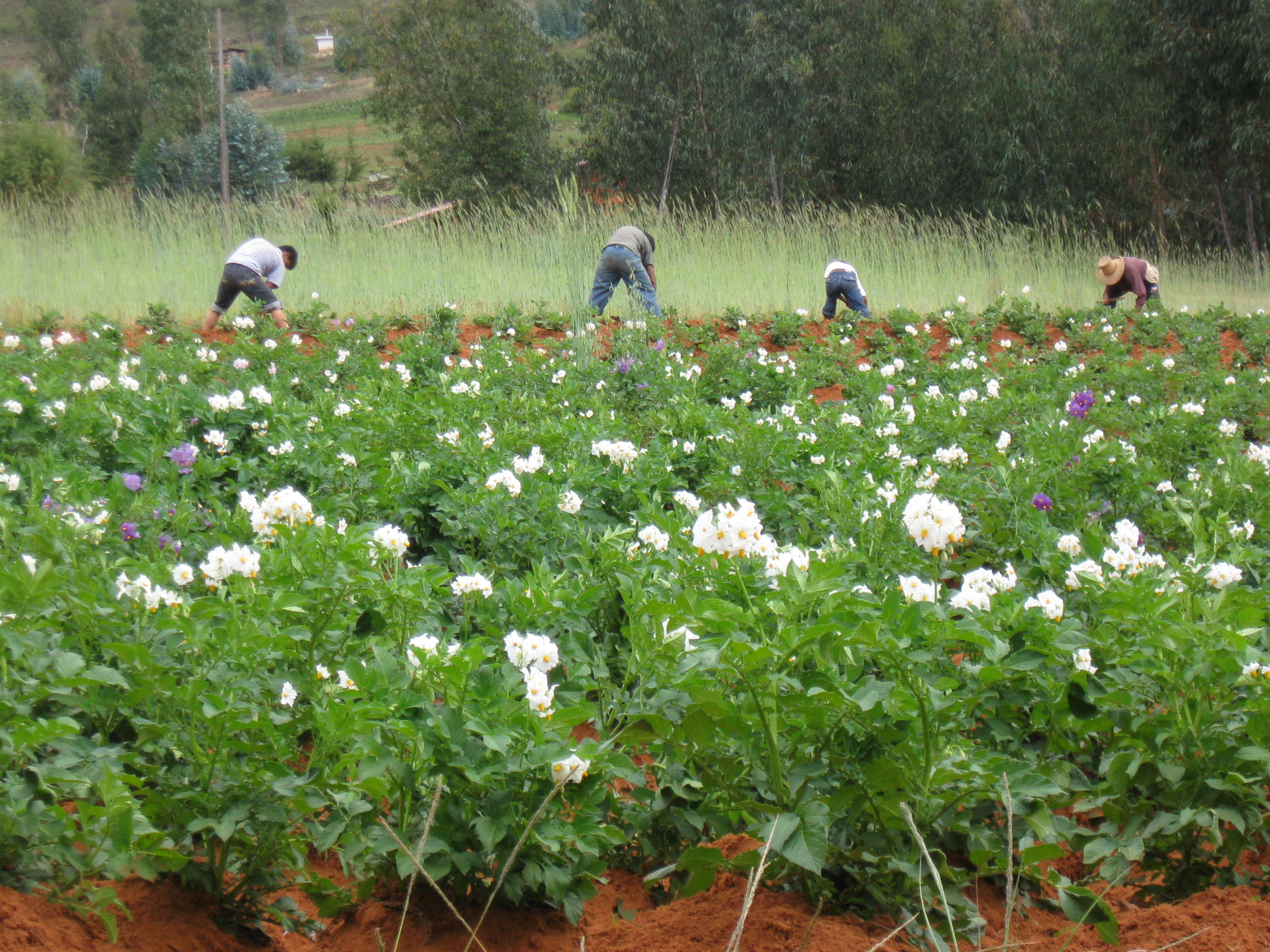- Sorry about the light blogging lately. I’m on leave and Jeremy is in the manure. Thankfully Robert has been picking up the slack lately, apparently because he has nothing better to do. Anyway, here’s a juicy roundup of Nibbles covering the past week and more. Starting with this stunner: Svalbard needs an adviser!
- Breeding better barley: The video. No videos, however, on breeding Africa’s orphan crops. Yet.
- Some of those are agroforestry species. Which is not confined to Africa, of course. But pomegranate is not included, alas for the Afghans. Nor the hazlenut, alas for the Australians, who will however admittedly probably sequence the thing themselves.)
- DivSeek does have a video, though.
- Even raspberry breeding has a video. But if this strawberry hack works for other plants, breeders might not be needed at all :)
- Orange-fleshed sweet potato folks meet in Ghana for annual jamboree.
- An insurance policy for agriculture? Yes, you guessed it.
- Recovering the NM chile. Hot stuff from a cold place. Yes, you guessed it. Again. (BTW, not only important in New Mexico.
- How to make a 17th century sallat. You heard me.
- CIAT on getting ahead of dietary trends. No, not from the 17th century. This being the current situation, however. And more specifically for dietary diversity among women. Yes, it’s all about diversification. Including in homegardens. Which were the great love of the great, late Olga Linares.
- The benefits would be so great to get nutrition right. And yet we haven’t. And without Olga it’s not going to be any easier. Maybe we could start by curing Indians of their pizza habit.
- The largest seed exchange in the world. It says here. There I was thinking it was the CGIAR genebanks.
- Rewilding Europe. Kinda sorta.
- The Dutch have new policies on conserving livestock genetic resources. At least yaks are not an issue.
- Meanwhile, the UK biodiversity indicators include one on crop genetic diversity.
- Maybe all it needs is better marketing, like these millets?
- Or perhaps a data portal, like wheat’s.
- Which may soon be out of date for the Punjab. Or should be, anyway, according to this IFPRI study. And also for the US, according to this maverick breeder getting a writeup in the NY Times.
- Be that as it may, help is on the way for wheat, in the form of its wild relatives. According to some people who should know.
- Interactive global deforestation map. Because we can.
- Black chicken? And why not? Not Icelandic, though, I’m willing to bet. Chickens? “…it was the forced opening of China by the West in the 1840s that made the modern [chicken] possible.” Not so the turkey, though.
- Ancient horse breeders liked spots. And then they didn’t. And then they did…
- Disease resistant Napier grass in Kenya. Must ask the mother-in-law whether she has some.
- Oh dear, Italian olives are in trouble. Again. Ah, yes, the olive, symbol of peace.
- Penang Botanic Gardens has a big birthday.
- Hope that keeps you going for a while…
European on farm diversification
In my previous post on the new EU Common Agricultural Policy, I missed that it promotes in situ conservation of crops. At least that is my reading of Annex IX, which provides a list of practices equivalent to crop diversification. The text is a bit confusing (why are legal documents never clear?); here’s an excerpt (my bolding):
- Crop Diversification
Requirement: at least three crops, the main crop covering a maximum of 75%, and any one or more of the following applying:
— there is a more appropriate selection of crops, such as, for example, leguminous, protein crops, crops not requiring irrigation or pesticide treatments, as appropriate,
— regional varieties of old, traditional or endangered crop types are included on at least 5% of the rotated area.
The ‘and‘ does not make sense, and should surely be ‘or‘? Otherwise there would be no ‘equivalency.’
Perhaps it is a European thing to emphasize the old & traditional over the novel & rare? Either way, there are busy times to come for European on farm conservation buffs! But where should interested farmers get seed? Many of these varieties may not be registered, and I thought that exchanging such seed was not legal in Europe?
Brainfood: Garden pollinators, Herbarium Analytics, Rice & nutrients, High altitude barley, Sunflower hybrids, Coconut pollen cryo, Evolution & dormancy, Evolution of C4, Maize landraces, Viruses
- Culturally valuable minority crops provide a succession of floral resources for flower visitors in traditional orchard gardens. Proper gardens better for pollinators than unmanaged plots.
- Trends in access of plant biodiversity data revealed by Google Analytics. No impact of social media on the use of plant data, and the future is mobiles.
- Worldwide Genetic Diversity for Mineral Element Concentrations in Rice Grain. Most, though not all, elements showed high heritability, which is good news for breeders.
- Agriculture facilitated permanent human occupation of the Tibetan Plateau after 3600 BP. No barley, no Tibetans.
- Seed fates in crop-wild hybrid sunflowers: crop allele and maternal effects. Having wild mothers helps wild-crop hybrids survive in the wild.
- Coconut (Cocos nucifera l.) pollen cryopreservation. Eureka!
- The evolution of seed dormancy: environmental cues, evolutionary hubs, and diversification of the seed plants. More dormancy, more speciation.
- The evolutionary ecology of C4 plants. C4 opens new niches, but it’s all a matter of contingency and you have to follow the whole evolutionary history of a group to understand its current ecological strategy.
- A Minor Role for Environmental Adaptation in Local–Scale Maize Landrace Distribution: Results from a Common Garden Experiment in Oaxaca, Mexico. It’s the social factors, stupid.
- Crop immunity against viruses: outcomes and future challenges. PAMP (pathogen-associated molecular patterns)-triggered immunity (PTI) may be the future.
A natural experiment with Peruvian potatoes
Potatoes are generally propagated vegetatively, by planting tubers. In English, these tubers used for planting are, unfortunately, referred to as seed, which they obviously aren’t, at least not in the botanical sense. Potato breeders use sexual reproduction and the resulting real seeds (extracted from the tomato-like potato fruits) to generate new varieties. The fabled potato diversity of the Andes probably originated from seeds arising from spontaneous crosses among landraces and with their wild relatives, and alert farmers that kept some of the offspring occurring in their fields. But when and where were Andean potato varieties formed? And is this type of evolution still going on?
Marc Ghislain and colleagues 1 took advantage of a natural experiment in Peru to investigate whether new varieties have arisen from crosses between ‘Yungay’, and other varieties. Yungay 2 is one of the varieties of the famous Peruvian potato researcher Carlos Ochoa, produced by crossing native and exotic potatoes (from Europe, the USA, and Chiloe). Because it is genetically rather distinct from native Peruvian varieties (here is its pedigree), Ghislain and colleagues were able to use genetic markers (SSRs, in fact) to determine if a given potato variety in a farmer’s field might be an offspring of Yungay.
They looked at the DNA of 1771 leaf samples from more than 400 potato varieties growing in areas where Yungay is also grown. None of the potatoes sampled could plausibly be identified as a descendant of Yungay.
The authors’ motive was to find out whether transgenes from genetically modified potatoes might ‘pollute’ native diversity. I am more interested in the question of whether farmers are still finding, keeping and spreading new varieties from spontaneous seedlings. That would seem likely, but there appears to be no good evidence that they do so. We know that hybridization among potato cultivars, and with wild species, occurs under field conditions, but what happens to the offspring? Ghislain and his colleagues suggest that hybrids may not be adapted, and thus die off, citing research carried out in the rather unforgiving climate of Puno, and that farmers discard hybrids because they prize the quality of native varieties. But I am not convinced by that argument. Clearly, many hybrids will not make the cut, as in any breeding program, but some novelty must surely be of interest to local farmers, as it obviously has been in the past.
Is keeping new potato varieties a cultural practice that has been lost? And are most current native potato varieties therefore old, perhaps very old? Or is the process still going on, perhaps even at a similar rate as before, but the chance of detecting it is small? I wonder if there is some sort of clock that can be used to measure how old a variety is. After all, a variety is really an individual clonally propagated plant. And some potato varieties are thus of course much larger organisms than those molds that occasionally hit the headlines; each year there are about 10,000 ha of Russet Burbank in the USA alone.
Unless there is simply something wrong with Yungay’s offspring (which would make it a bad variety to use for this type of research), my guess is that there are hybrids with Yungay out there, but not many, and that they are just very hard to find. Only very few novel varieties may be good enough to spread beyond a farm to a much larger area, such that we are likely to detect them. But a transgene hybrid could have better odds than most.
Evaluating germplasm comes of age
Germplasm evaluation: yeah, sure, you can do it old-school style.
It was ascertained whether the collection of cucumber varieties of our Institute contained any non-bitter plants. At first no rapid chemical method was available for distinguishing the non-bitter plants from the bitter ones. Therefore tasting them was the only usable method. Although a large number of plants can be rapidly tasted, there are some drawbacks.
I bet there are.
A relatively small number of people working at our Institute was found to be capable of picking out correctly the plants that were non-bitter. As a rule a good taster cannot treat more than 20 to 30 plants at a time. The taster has to correct his taste now and then by consuming for instance a piece of toast or apple.
But our intrepid cucumber breeders persevered, and were suitably, if belatedly, rewarded (italics added).
When grown on in a glasshouse the vegetative parts of all plants but one were not entirely free from bitter principle. Although under our conditions none of these plants produced bitter fruits, all the plants that had traces of bitter principles in their vegetative parts were removed. At the end of the growing season only one out of the 15,000 plants tested remained.
But that was in the 1950s. And that’s a foreign country. This is how breeders roll these days:
Cucurbitacins are triterpenoids that confer a bitter taste in cucurbits such as cucumber, melon, watermelon, squash, and pumpkin. These compounds discourage most pests on the plant and have also been shown to have antitumor properties. With genomics and biochemistry, we identified nine cucumber genes in the pathway for biosynthesis of cucurbitacin C and elucidated four catalytic steps. We discovered transcription factors Bl (Bitter leaf) and Bt (Bitter fruit) that regulate this pathway in leaves and fruits, respectively. Traces in genomic signatures indicated that selection imposed on Bt during domestication led to derivation of nonbitter cucurbits from their bitter ancestors.
Which is cool, don’t get me wrong. But somehow seems to take the romance — and fun — out of it.
Incidentally, that one nice-tasting cucumber was an Improved Long Green.

